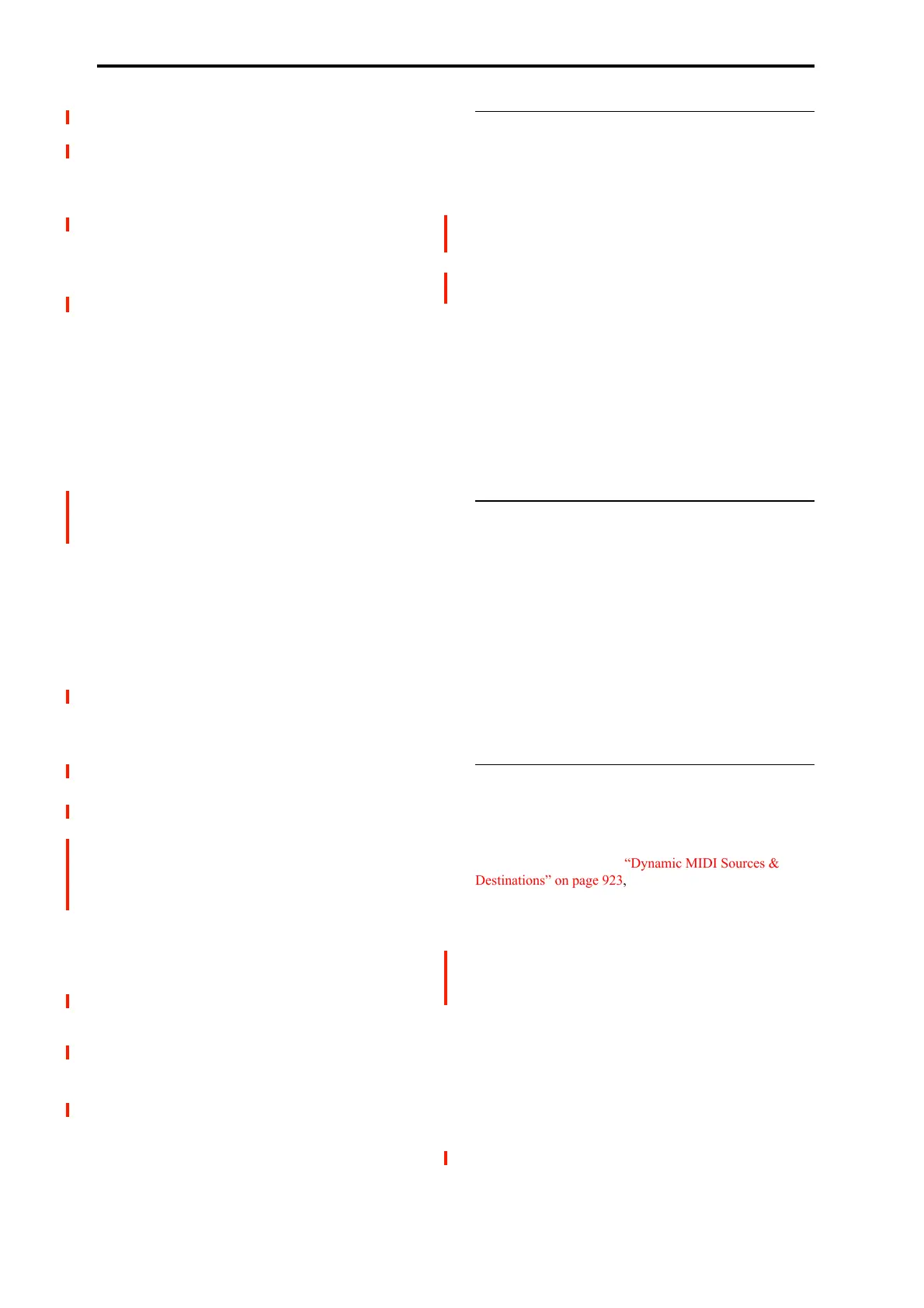Appendices
930
In SEQUENCER mode, program change or bank select
messages will be transmitted by tracks whose Status is
Both, EXT, or EX2 when you select the “Program Select”
parameter (0–1b), when you select a song, or when you
return to the beginning of a measure. (See “0–1b: Status
Play/Mute” on page 446.)
• In COMBINATION and SEQUENCER modes,
transmission/reception can be switched on/off for each
timbre/track. See “Enable Program Change” on
page 413, and “Enable Program Change” on page 489.
SET LIST mode
• Program Change messages on the Global Channel select
the Slot, and Bank Select messages on the Global
Channel select the Set List.
When a Slot is selected via MIDI, the display updates if
necessary to show the appropriate group of 16 buttons.
• Selecting a Slot sends Program Change and Bank Select
messages, as above.
When selected, Combinations and Songs can transmit
other Program Change and Bank Select messages on
other channels, as they do in COMBINATION and
SEQUENCER modes.
• The GLOBAL > Basic Setup– Bank Map (Korg,
GM(2)) parameter does not affect the reception or
transmission of Set List Program and Bank Select
messages.
Selecting combinations
You can use program change and bank select messages to
select combinations in the same way that you select
programs.
• Combinations 000–127 in banks A...N correspond to
program changes [Cn, 00]–[Cn, 7F].
• Similarly as for program banks, the internal banks that
correspond to each bank select number will depend on
the “Bank Map” setting (GLOBAL 0–1d). For more
information, see “Bank Map” on page 633.
• In COMBINATION > Home page, program change and
bank select messages are transmitted/received on the
global MIDI channel. They are not received except in
Home page.
Note: All program changes can be turned off in MIDI Filter
(GLOBAL 1–1c)
As needed, you can independently turn all program changes
on/off, specify whether or not incoming messages will be
able to change combinations, and turn
reception/transmission of bank select messages on/off.
• If “Enable Combination Change” (GLOBAL 1–1c) is
unchecked, the combination will not change even if a
program change on the global MIDI channel is received
in COMBINATION P0: Play. In this case, the program
of the timbre that matches the MIDI channel of the
received message will change.
• If “Enable Bank Change” (GLOBAL 1–1c) is
unchecked, bank select messages will not be transmitted
or received.
After touch
Channel aftertouch [Dn, vv]
(n: channel, vv: value)
• After touch for the entire instrument can be turned on/off
in “Enable After Touch” (GLOBAL 1–1c).
• In COMBINATION and SEQUENCER modes, after
touch can be switched on/off independently for each
timbre/track (“Enable After Touch” COMBINATION 3–
1a, SEQUENCER 3–1a).
Polyphonic aftertouch [An, kk, vv]
(n: channel, kk: note number, vv: value)
There is another type of after touch called Polyphonic Key
Pressure, which allows after touch to be applied
independently for individual keys. This message can be used
as an alternate modulation source, but cannot be transmitted
by the NAUTILUS’s keyboard. In order to use this message,
it will have to be received from an external device, or
recorded on your sequencer.
Pitch bend
Pitch bend change [En, bb, mm]
(n: channel, bb: lower byte of the value, mm: upper byte of
the value, together expressing a value of 16,384 steps where
8,192 [bb, mm = 00H, 40H] is the center value)
When the NAUTILUS’s joystick is moved in the X axis
(left/right), a pitch bend effect will be applied, and pitch
bender messages will also be transmitted. When these
messages are received, a pitch bend effect will be applied.
The range of pitch change that is produced by pitch bend
messages can also be adjusted via MIDI. (See “Changing the
pitch bend range” on page 934.)
Control change
[Bn, cc, vv]
Transmitted and received as (n: channel, cc: control change
no., vv: value)
For more information, see “Dynamic MIDI Sources &
Destinations” on page 923, “MIDI transmission from
NAUTILUS controllers” on page 918, and “NAUTILUS
and MIDI CCs” on page 921
• Control changes can be turned on/off as a whole in
“Enable Control Change” (GLOBAL 1–1c).
• In COMBINATION and SEQUENCER modes, the
MIDI FIlter/Zones– MIDI Filter settings allow
transmission/reception of control changes to be
individually turned on/off for each timbre/track. For the
assignable controllers (SW1, SW2, RT control knobs 1–
6, Foot Pedal/Switch), MIDI filter settings will apply to
the control change number to which each controller is
assigned. “Other Control Change” applies to control
changes that are not covered by the items of the other
check boxes.
Note: You can select MIDI CC#00–CC#119 for “RT control
knobs 1...6.”
Although you can select MIDI CC#00–CC#119 for the ARP
controllers (ARP button, LATCH button, DRUM button,
SELECT button is the RT control knob when ARP DRUM)

